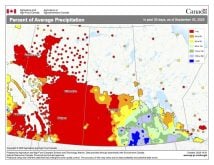Reuters – The European Union’s crop monitoring service further reduced its yield forecasts July 24 for this year’s harvest, citing dry and hot weather.
Crop prospects in the bloc have taken on extra significance since Russia’s invasion of Ukraine, a major wheat, corn and sunflower exporter, has disrupted Black Sea exports and raised uncertainty over Ukraine’s harvest.
Scorching temperatures in many parts of the EU and excessive rains elsewhere have reduced hopes of a bumper crop.
Read Also

Manitoba farmers uneasy on expropriation
Farmland expropriation for Oak Bluff highway project brings process, farmer compensation concerns back to the fore.
In its monthly outlook, the service cut its yield forecast for soft wheat, the largest crop grown in the EU, to 86 bushels per acre from 588 bu./acre projected last month. The forecast is now in line with the five-year average.
For grain maize, due to be harvested later this year, the service cut its yield forecast to 112 bu./acre from 113 bu./acre last month. That would still be one per cent above average and 28 per cent above the drought-ravaged 2022 harvest.
The monitor had already reduced nearly all its average yield forecasts for this year’s crops last month.
Intense heatwaves in the southern parts of the Iberian Peninsula and northern Italy could cause sterility for flowering summer crops, with potentially irreversible impacts on yields, it said.
In contrast, a surplus of rainfall delayed harvesting and potentially reduced grain quality in western parts of Bulgaria and Romania, Slovenia, Croatia and Hungary.
The biggest cut was for sunflower, for which yields were reduced by four per cent from last month to 31 bu./acre and are now expected to be five per cent below average.
It also sharply cut its spring barley yield forecast, to 54 bu./acre, 14 per cent below 2022 yields.
Rapeseed is now expected to hit 47 bu./acre from 49 bu./acre last month, still three per cent above average.














